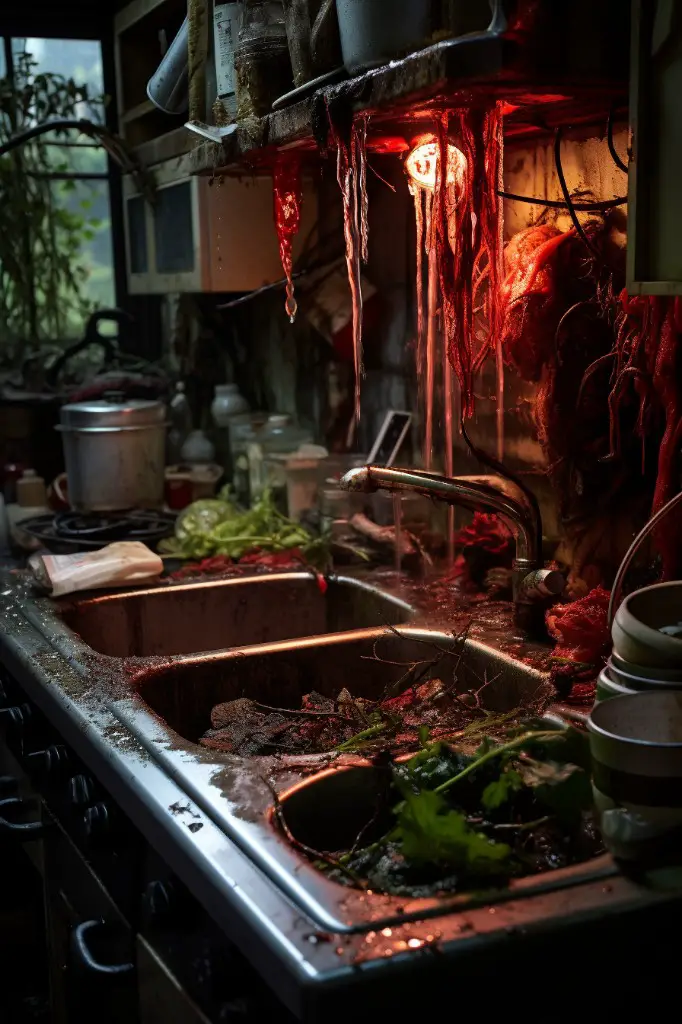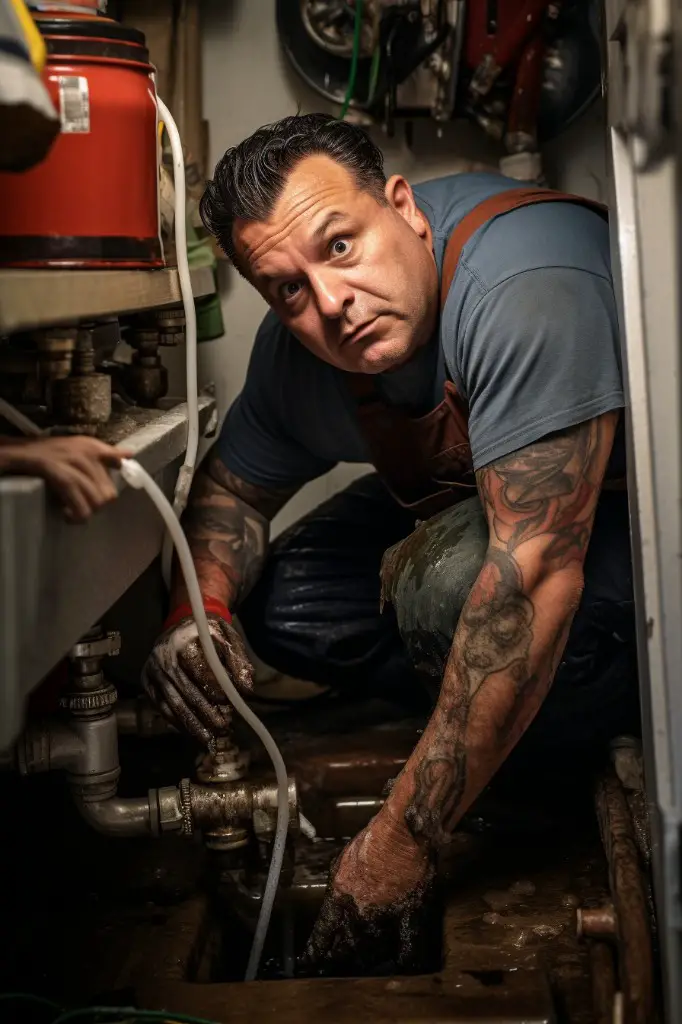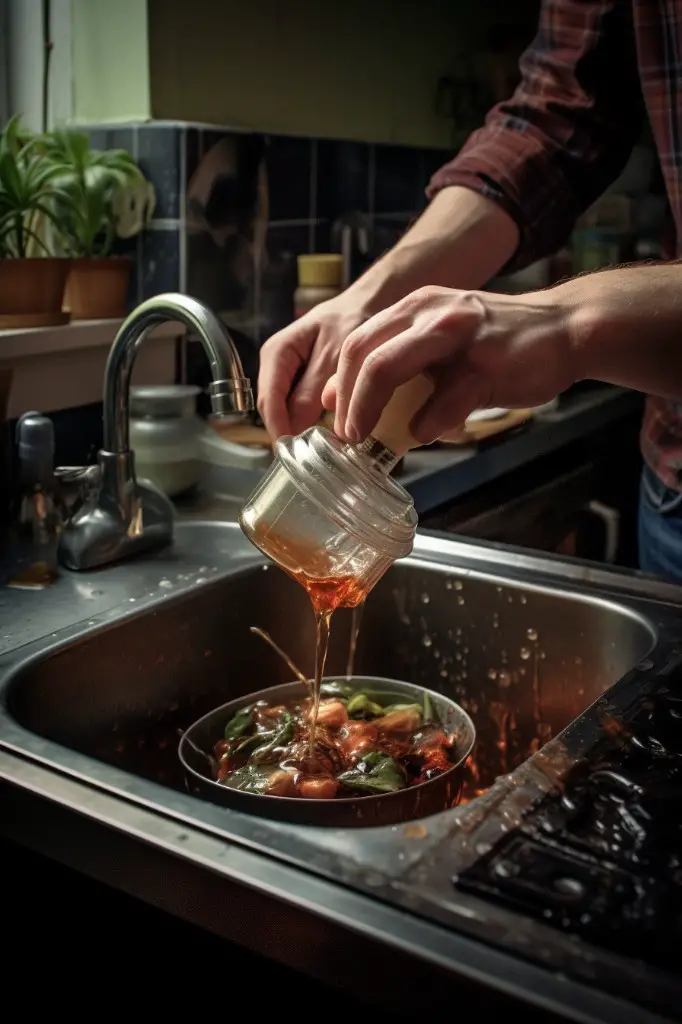Last updated on
Discover the effective steps to eliminate that annoying gurgling sound in your kitchen sink and restore its proper function for a peaceful cooking experience.
Have you ever experienced the annoying sound of gurgling coming from your kitchen sink? It can be frustrating, especially when it seems to happen at the most inconvenient times. But fear not, because fixing a gurgling kitchen sink is easier than you might think.
In this article, we’ll explore some common causes of gurgling sinks and provide easy-to-follow tips on how to fix them. So grab your tools and let’s get started!
What's Inside
Common Causes of Sink Gurgling

One of the most common causes is a clogged drain. When food particles, grease, and other debris accumulate in the pipes over time, they can create blockages that prevent water from flowing freely through them.
Another possible cause of sink gurgling is a blocked vent pipe. Vent pipes allow air to enter the plumbing system and equalize pressure as water flows through it.
If these pipes become obstructed by leaves or other debris, it can cause negative pressure to build up in your plumbing system and result in gurgling noises.
A malfunctioning garbage disposal unit could also be responsible for causing your kitchen sink to make strange noises when draining water down its drainpipe. In some cases, poorly installed or damaged sewer lines may also lead to this problem.
Identify the Cause

There are several reasons why your sink may be making that annoying sound, and each requires a different solution. One common cause of gurgling sinks is clogged drains or pipes.
This can happen when food particles, grease, soap scum, and other debris accumulate in your drain over time.
Another possible culprit could be an issue with your garbage disposal unit or vent system. A malfunctioning garbage disposal can lead to blockages that prevent water from flowing freely through the pipes while blocked vents can create negative pressure within the plumbing system causing air bubbles to form.
To identify what’s causing your sink to gurgle, start by running hot water down it for about 30 seconds before turning off all taps connected to it including those on nearby appliances like dishwashers and washing machines if any exist. If you still hear a noise after doing this test then try pouring some baking soda followed by vinegar into the drain as this will help break up any clogs present inside.
Clear the Sink Drain

Over time, food particles, grease, and other debris can accumulate in your sink’s drainpipe and cause blockages that prevent water from flowing freely. To clear the sink drain:
- Start by removing any visible debris or buildup from around the opening of your sink’s drain.
- Next, use a plunger to try to dislodge any stubborn clogs further down in the pipe.
- If plunging doesn’t work, you can try using a plumbing snake or auger to break up and remove more significant blockages.
- Another option is pouring boiling water down your kitchen sink’s drain slowly.
Using a Drain Cleaner

Drain cleaners are designed to dissolve clogs that can’t be removed by other methods. However, it’s important to choose the right type of cleaner for your specific situation.
There are two main types of drain cleaners: chemical and enzymatic. Chemical cleaners work quickly but can damage pipes if used improperly or too frequently.
Enzymatic cleaners take longer to work but are safer for pipes and more environmentally friendly.
When using a chemical cleaner, always follow the manufacturer’s instructions carefully and wear protective gloves and eyewear. Pour the recommended amount into your sink drain, let it sit for several minutes (or as directed), then flush with hot water.
Enzymatic cleaners require patience since they need time to break down organic matter in your drains slowly. Pouring them before bedtime is an excellent idea because they will have enough time overnight without any interference from running water or other activities in the kitchen.
How To Unclog a Kitchen Sink With Standing Water
There are a few simple steps you can take to unclog the drain and get rid of the standing water.
First, try using a plunger. Fill the sink with enough water to cover the rubber part of the plunger, then place it over the drain and push down firmly several times.
This will create suction that can help dislodge any blockages in your pipes.
If plunging doesn’t work, you may need to use an auger or snake. These tools are designed specifically for clearing clogs from drains and pipes.
Insert them into your drain until you feel resistance, then turn them clockwise while pushing forward until they break through whatever is causing the blockage.
Another option is using baking soda and vinegar solution which works well on minor clogs but not so much on major ones.
Use a Plunger
To do this, fill your sink with enough water to cover the rubber part of your plunger and place it over the drain. Push down on the plunger firmly and then pull up quickly several times until you feel suction being created.
After plunging for a few minutes, remove the plunger and run hot water down your kitchen sink for about five minutes. This will help flush out any remaining debris that may have been dislodged by plunging.
Remove the Clog With an Auger or Snake
These tools are designed to reach deep into your pipes and remove any stubborn clogs that may be causing your sink to gurgle.
To use an auger or snake, start by inserting it into the drain opening and turning it clockwise until you feel resistance. Then, slowly push down on the tool while continuing to turn it clockwise.
This will help break up any clogs in your pipes.
Once you’ve reached as far as possible with the auger or snake, pull out gently while still turning clockwise. You should feel some resistance if there is anything caught on the end of your tool – this is good news! Keep pulling until you have removed all debris from inside of your pipe.
After removing all debris from inside of your pipe using an auger/snake make sure that water flows freely through both sides before reassembling everything back together again.
Clean the P-Trap
The P-trap is a curved pipe located under your sink that traps debris and prevents sewer gases from entering your home. Over time, this trap can become clogged with food particles, grease or other debris causing water to back up into your sink.
To clean the P-trap:
- Turn off both hot and cold water supply valves.
- Place a bucket underneath the trap to catch any excess water.
- Loosen slip nuts on either side of p-trap by hand or with pliers.
- Remove p-trap carefully so as not to spill contents in bucket below
- Clean out any debris inside of it using gloves if necessary
- Reattach all parts securely
Once you’ve cleaned out any blockages in your P-Trap, run hot water down each side for several minutes before reassembling everything tightly again.
Inspect the Garbage Disposal
If your sink has one, it’s important to inspect it for any issues that may be causing the gurgling sound.
First, turn off the power supply to your garbage disposal by unplugging it or turning off its circuit breaker. Then, use a flashlight to check inside for any visible blockages or damage.
You can also try manually rotating the blades with an Allen wrench (usually provided with most disposals) in case they are jammed.
If you notice anything unusual such as cracks in the housing or damaged blades, you may need to replace your garbage disposal entirely. However, if everything looks fine and there are no visible blockages present but still experiencing gurgling sounds from your sink when using this appliance then move on and check other possible causes mentioned above before calling out professionals for help.
Check for Vent Blockage
The plumbing system in your home has a vent pipe that runs up through the roof to allow air into the pipes. This helps prevent water from being siphoned out of traps and allows waste to flow freely down the drain.
However, if this vent becomes blocked by debris or animal nests, it can cause negative pressure in your pipes and lead to gurgling sounds. To check for a blocked vent pipe, go outside with a ladder and look at where it exits on your roof.
If you see any obstructions like leaves or bird nests around the opening of this pipe, remove them carefully using gloves or other protective gear.
Vent Pipe Blockages
The vent pipe allows air to flow into the plumbing system, which helps water drain smoothly and prevents suction from forming that can slow down or stop drainage. If this pipe becomes blocked, it can cause negative pressure in your pipes and lead to gurgling sounds.
To check for a blockage, locate your home’s main vent stack on the roof and inspect it for any visible debris or obstructions such as leaves or bird nests. You may also need to climb onto your roof with a flashlight if you suspect there is an obstruction further down inside the piping.
If you find an obstruction, carefully remove it using gloves and other protective gear as necessary. Be sure not to damage any part of the piping while doing so.
Once cleared out, run some hot water through all drains connected to that particular line (kitchen sink) for several minutes before testing again by running cold water through them one at a time.
Install an Air Admittance Valve
This device allows air into the plumbing system, preventing negative pressure from building up and causing water to flow back into your sink. Installing an air admittance valve is a relatively simple process that can be done by most homeowners with basic DIY skills.
To install an air admittance valve, start by turning off the water supply to your sink. Then locate the vent pipe under your kitchen sink and remove any existing fittings or caps on top of it.
Next, insert the new air admittance valve onto the vent pipe until it fits snugly in place.
Once installed correctly, turn on your faucet and check for any leaks around where you installed the new device.
Fixing an Air Admittance Valve
This device is designed to regulate air pressure in your plumbing system, preventing water from being siphoned out of the trap and causing that annoying gurgling sound.
To install an air admittance valve, start by turning off the water supply to your sink. Then locate the existing vent pipe under your sink or behind a nearby wall.
Remove any fittings or connections on this pipe so that you can attach the new valve.
Next, insert one end of a rubber coupling onto each side of where you removed any fittings on top of vent pipes (the size should match). Slide them down until they are snugly fit over both ends before tightening with clamps at either end using pliers for extra grip if necessary.
Flush the System
Flushing involves running a large amount of water through your pipes to clear out any remaining debris or buildup that could be causing the problem.
To do this, start by filling up a large pot with hot water and pouring it down each drain in your kitchen. This will help break up any grease or food particles that may have accumulated in your pipes.
Next, turn on all of the faucets in your kitchen and let them run for several minutes. This will allow fresh water to flow through every part of your plumbing system, helping to dislodge anything that might be causing blockages.
Consider using an enzymatic cleaner designed specifically for drains. These cleaners contain natural enzymes that can break down organic matter like food scraps and grease without damaging pipes or harming the environment.
Poorly Installed Pipes
If the pipes are not properly aligned or connected, it can cause air pockets that lead to gurgling sounds. This is especially common in older homes where plumbing systems have been modified over time.
If you suspect that poorly installed pipes are causing your sink to gurgle, it’s best to call a professional plumber for an inspection. They will be able to identify any issues with your plumbing system and recommend appropriate solutions.
In some cases, fixing poorly installed pipes may require extensive repairs or even replacement of certain sections of the piping system. While this can be costly and time-consuming, it’s important not only for eliminating the annoying sound but also for ensuring proper functioning of your entire plumbing system.
Repair or Replace Pipes
Over time, pipes can become corroded or damaged due to wear and tear. This can cause blockages that lead to gurgling sounds in the sink.
Repairing or replacing pipes is not a DIY job for most homeowners. It’s best left to professional plumbers who have the expertise and tools necessary for this type of work.
A plumber will first inspect your plumbing system using specialized equipment such as cameras that are inserted into the pipe system. They’ll identify any damage, corrosion, leaks or clogs in your plumbing system before recommending repair options.
In some cases where there’s extensive damage beyond repair like collapsed sewer lines caused by tree roots intrusion; replacement may be necessary instead of repairs. Replacing old worn-out piping with new ones will ensure proper water flow without any obstructions which could lead to future problems like backups causing more serious issues than just a gurgling sound from sinks.
Damaged Sewer Pipes
Damaged sewer pipes can cause water to back up into your home’s plumbing system, leading to unpleasant smells and gurgling sounds in sinks and toilets.
Sewer pipe damage can occur due to various reasons such as tree root intrusion, corrosion or age-related wear-and-tear. If you suspect that damaged sewer pipes are causing the problem with your kitchen sink, it’s best to call a professional plumber immediately.
A licensed plumber will have specialized equipment like cameras for inspecting inside of pipes without digging them up. They’ll be able to identify any issues with the sewer line quickly and provide an appropriate solution based on their findings.
Ignoring damaged sewer lines could lead not only lead to further damage but also pose health risks from exposure harmful bacteria present in sewage waste materials.
Clogs in the Sewer Line
This can be caused by various factors such as tree roots, debris buildup or even collapsed pipes. A clogged sewer line can cause water to back up into your sink and create gurgling sounds.
To fix this issue, you’ll need to call a professional plumber who has specialized equipment like drain cameras or hydro-jetters to locate and remove the blockage from your sewer line. It’s important not to ignore this problem as it could lead to more serious issues like sewage backup which is both unpleasant and hazardous.
Maintain Your Sink Regularly
To avoid future gurgling issues, it’s essential to maintain your sink regularly. One of the easiest ways to do this is by running hot water down the drain after each use.
This helps dissolve any grease or food particles that may have accumulated in the pipes.
Another way to keep your sink functioning properly is by using a strainer over the drain opening. This will prevent large food particles from going down into your pipes and causing clogs.
You can pour a mixture of baking soda and vinegar down your drain once every few weeks as an effective natural cleaner that breaks up any buildup inside.
By following these simple maintenance tips regularly, you can help ensure that gurgling sounds don’t become a regular occurrence in your kitchen sink!
FAQ
What causes kitchen sink to gurgle?
A kitchen sink gurgles due to airflow problems in the drain pipe, which can be caused by a clog, blockage, or improper installation.
What happens if you don’t fix a gurgling sink?
If a gurgling sink is not fixed, it can lead to larger plumbing issues due to air seeping through an existing blockage, allowing more debris to become trapped.
Why does my dishwasher make a gurgling sound when I drain?
Your dishwasher makes a gurgling sound when draining due to a clog or partial clog in the pipes, obstructing the free flow of water.
How can I troubleshoot the source of gurgling in my kitchen sink?
To troubleshoot the source of gurgling in your kitchen sink, inspect the drain, check for clogs, and ensure proper venting for optimal airflow.
Are there any DIY methods to fix a gurgling sink without calling a plumber?
One DIY method to fix a gurgling sink is to use a plunger, clean the drain pipe, and check the vents for any blockages.
When should I consider replacing my sink or plumbing system due to persistent gurgling issues?
You should consider replacing your sink or plumbing system due to persistent gurgling issues when preventative maintenance and minor repairs are no longer effective.




